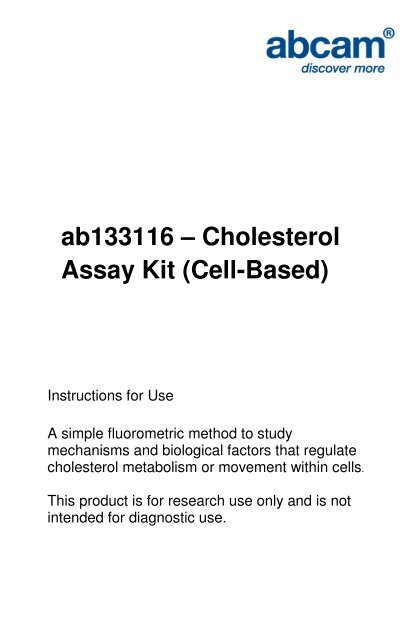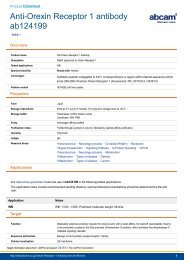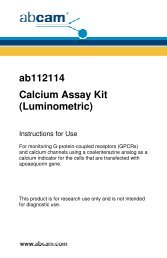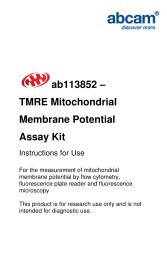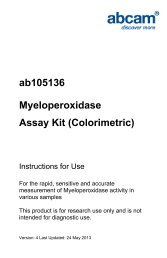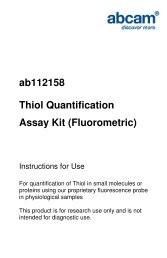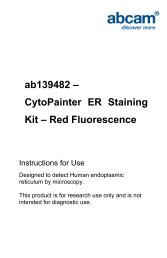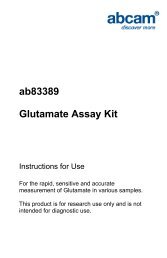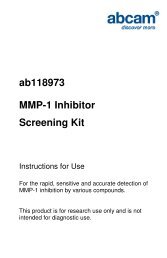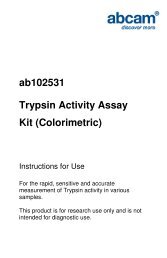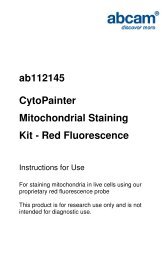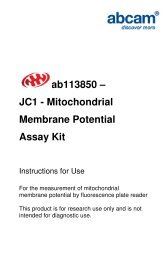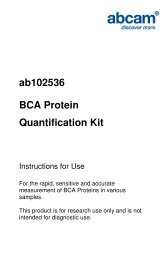ab133116 â Cholesterol Assay Kit (Cell-Based) - Abcam
ab133116 â Cholesterol Assay Kit (Cell-Based) - Abcam
ab133116 â Cholesterol Assay Kit (Cell-Based) - Abcam
Create successful ePaper yourself
Turn your PDF publications into a flip-book with our unique Google optimized e-Paper software.
<strong>ab133116</strong> – <strong>Cholesterol</strong><strong>Assay</strong> <strong>Kit</strong> (<strong>Cell</strong>-<strong>Based</strong>)Instructions for UseA simple fluorometric method to studymechanisms and biological factors that regulatecholesterol metabolism or movement within cells.This product is for research use only and is notintended for diagnostic use.
Table of Contents1. Overview 22. Background 33. Components and Storage 54. Pre-<strong>Assay</strong> Preparation 65. <strong>Assay</strong> Protocol 76. Data Analysis 91
1. Overview<strong>ab133116</strong> includes filipin III, fixative, and wash buffer in a ready touse format. It provides a simple fluorometric method to studymechanisms and biological factors that regulate cholesterolmetabolism or movement within cells. A cholesterol traffickinginhibitor, U-18666A, is included as a positive control.2
3. Components and Storage<strong>Kit</strong> will arrive packaged as a -20°C kit. For best results, removecomponents and store as stated below.ItemQuantity Storage<strong>Cell</strong>-<strong>Based</strong> <strong>Assay</strong> Fixative 2 vials RT<strong>Cholesterol</strong> Detection Wash Buffer 1 vial RT<strong>Cholesterol</strong> Detection Filipin III 1 vial -20°C<strong>Cholesterol</strong> Detection <strong>Assay</strong> Buffer 1 vial RT<strong>Cell</strong>-<strong>Based</strong> <strong>Assay</strong> U-18666A 1 vial -20°CMaterials Needed But Not Supplied• A 6-, 12-, 24-, or 96-well plate.• A fluorescence microscope equipped with a UV filter setcapable of excitation and emission wavelengths of 340-380nm and 385-470 nm, respectively.5
4. Pre-<strong>Assay</strong> PreparationNOTE: Filipin III is light sensitive. Do not expose to direct intenselight.Preparing the Filipin III Stock SolutionDissolve the whole vial of <strong>Cholesterol</strong> Detection Filipin III in200 µl of 100% ethanol. We highly recommend that you makesmall aliquots and store them at -80°C. NOTE: Filipin III is veryunstable in solution and its activity decreases significantly witheach use.6
5. <strong>Assay</strong> ProtocolA. Treatment of <strong>Cell</strong>sThe following protocol is designed for a 96-well plate. Adjustvolumes accordingly for other plate sizes.1. Seed wells of a 96-well plate with 3 x 10 4 cells/well. Growcells overnight.2. The next day, treat cells with experimental compounds orvehicle control for 48-72 hours, or for the period of time usedin your typical experimental protocol. <strong>Cell</strong>-<strong>Based</strong> <strong>Assay</strong> U-18666A, a cholesterol transport inhibitor, is included in thekit to be used as a positive control (provided at aconcentration of 2.5 mM). We recommend that you useserial of dilutions of U-18666A starting at 1.25 µM.3. Examine cholesterol localization using the following stainingprocedure.B. Histochemical Staining ProcedureNOTE: Perform all steps at room temperature.1. Remove most of the culture medium from the wells.2. Fix the cells with <strong>Cell</strong>-<strong>Based</strong> <strong>Assay</strong> Fixative Solution for 10minutes.7
3. Wash the cells with <strong>Cholesterol</strong> Detection Wash Buffer,three times, for five minutes each.4. Dilute the Filipin III Stock Solution (prepared as described inPre-<strong>Assay</strong> Preparation) 1:100 in <strong>Cholesterol</strong> Detection<strong>Assay</strong> Buffer. Add 100 µl of this Filipin III Solution to eachwell. Incubate in the dark for 30-60 minutes.5. Wash the cells with wash buffer, two times, for five minuteseach.6. Examine the staining using a fluorescent microscope usingan excitation of 340-380 nm and emission of 385-470 nm.Filipin fluorescent staining photobleaches very rapidly, thusthe sample should be analyzed immediately.8
6. Data AnalysisPerformance Characteristics - Typical Staining ResultsFigure 1. Accumulation of cholesterol inside HepG2 cells inresponse to 1.25 µM U-18666A. HepG2 cells were seeded in a96-well plate at a density of 3 x 10 4cells/well and culturedovernight. The next day, cells were treated with DMSO (vehicle)or 1.25 µM U-18666A for 48 hours. Panel A: <strong>Cell</strong>s treated withDMSO alone demonstrate that majority of cholesterol is localizedon the plasma membrane. Panel B: U-18666A treatment for 48hours induces intracellular accumulation.9
UK, EU and ROWEmail:technical@abcam.comTel: +44 (0)1223 696000www.abcam.comUS, Canada and Latin AmericaEmail: us.technical@abcam.comTel: 888-77-ABCAM (22226)www.abcam.comChina and Asia PacificEmail: hk.technical@abcam.comTel: 108008523689 ( 中 國 聯 通 )www.abcam.cnJapanEmail: technical@abcam.co.jpTel: +81-(0)3-6231-0940www.abcam.co.jp11Copyright © 2012 <strong>Abcam</strong>, All Rights Reserved. The <strong>Abcam</strong> logo is a registered trademark.All information / detail is correct at time of going to print.


